|
Manuel Portela
Grupo de Estudos Anglo-Americanos
Faculdade de Letras da Universidade de Coimbra
3004-583 Coimbra
Portugal
Tel. +351 239 859982
Fax: +351 239 836733
mportela@fl.uc.pt
Keywords
digital poetry, concrete poetry, intermedia genres, computer animated
poetry, Augusto de Campos, E.M. de Melo e Castro, Tiago Gomez Rodrigues
Abstract
I argue that there is an intrinsic connection between concrete poetics
as a theory of the medium (i.e., of language, of written language, and
of poetical forms) and digital poetics as a theory of poetry for the
digital medium. This link is clearly seen in the use of concrete poems
as storyboards and scripts for electronic texts, both in composing text
for graphic interface static display and for animation. This essay
deals with the adoption of electronic media by concrete poets, with
examples from the work of Brazilian poet Augusto de Campos (1931-), and
Portuguese poets E.M. de Melo e Castro (1932-) and Tiago Gomez
Rodrigues (1972-).
Introduction
I argue that there is an intrinsic connection between concrete poetics
as a theory of the medium (i.e., of language, of written language, and
of poetical forms) and digital poetics as a theory of poetry for the
digital medium. This link is clearly seen in the use of concrete poems
as storyboards and scripts for electronic texts, both in composing text
for graphic interface static display and for animation. It is as if the
concrete approach to language and form, because of its constructivist
and objectivist emphasis, anticipated the kind of reflection on media
set in motion by the electronic page. Close attention to the visibility
of language and to the materiality of reading, two of the central
tenets of concretist texts, also underlie many of the poetic attempts
to use the specific properties of electronic textuality in digital
forms. This essay deals with the adoption of electronic media by
concrete poets.
I want to point to the confluence of concrete and digital poetics in
the work of Brazilian poet Augusto de Campos (1931-), and Portuguese
poets E.M. de Melo e Castro (1932-), and Tiago Gomez Rodrigues (1972-).
The particular significance of Augusto de Campos and E.M. de Melo e
Castro for my argument is that they were both pioneers of concrete
poetics in the 1950s and 1960s and they have adopted computers in their
creative process in the early stages of the development of personal
computing in the 1980s. Tiago Gomez Rodrigues, on the other hand, is a
digital and multimedia artist, who, in his digital film-poem Concretus
(2002), self-consciously extends concretist research of the materiality
of sound and writing into the textuality of the digital medium, in
which sound, text, movement and music combine in new intermedia genres.
The Poem As A Language Generator
|
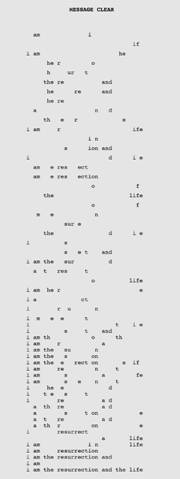 |
| |
The
adoption of computers as a means for literary creation has been
fostered by concrete poetics. Because of its internalization of a
theory of language as a structural system of signs, the concrete poem
laboratory explores the projection of the paradigmatic axis into the
syntagmatic axis. This probabilistic game with phonetic and semantic
similarities and differences is spatialized on the page, in such a way
that it foregrounds the fact that a text is always a set of
instructions for reading itself. Consequently, the combinatorial
procedures that have generated the rhetorical and typographic code of
the poem become visible on the textual surface. In retrospect, the poem
appears as a script of meaning, even if this meaning is not entirely
determinable. Despite their reliance on the ambiguity that results from
superposition of sense and sound states, many concrete poems focus on
language and print as technical devices for producing and exchanging
information. See, for example, Edwin Morgan’s Message Clear (1965),
where the bits and bytes that produce verbal meaning have been
decomposed, as if the poem intended to present us with the machine-code
for the miracle of transubstantiation that occurs in linguistic signs
(Figure 1). This is the kind of metalinguistic analysis that
signals concrete self-reference to the poem’s information code. For
concrete aesthetics, the dynamics of a syntactical combination that
resulted from phonetic and graphical attractions and lexical
cross-breeding is the guiding principle of composition.
|
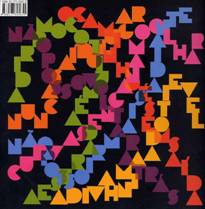 |
| |
Its
conscious and subconscious workings may be observed both below and
above the word level: in the first case in the agglutinations,
prefixes, infixes, suffixes, and various types of fragmentation of both
lexemes, morphemes and even graphemes; in the second case, at the
higher level of syntactic units, sentences, and texts. These procedures
subject the semantic and ideological level of language to a
combinatorial art that, at one and the same time, destroys and
reconstructs the texture of inferences and recurrences that upholds
discursive coherence. Concrete poetics moulds the structural and
psychic materiality of the sign by linking its formal linguistic
properties with the mind processing of those properties. Thus it is a
poetics of spoken and written language, as much as it is a poetics of
hearing and reading. Its hermeneutics starts at the physiological
processing of audiovisual input, which transmutes the poem into a
cyborg, that is, a cybernetic simulation of meaning as a specific
processing of information.
From
this point of view, the concrete poem is a kind of language generator
which provides a microcosm both of the linguistic processes of word and
sentence creation, and of the more basic and fundamental structuring
processes of the phonetic, syntactical, semantic, and pragmatic
elements that produce language. Language is not a mere repertoire of
given elements, classes of elements, and combinations of those classes,
but it is above all the possibility of expanding elements, classes, and
combinations. Such a virtualization of the infinity of language has
implied that poetical production should also take place at the more
fundamental levels of the linguistic sign and written signification.
Language as a means of production had to be pulled apart and
scrutinized in its microscopic materiality.
Peeling
of words and phonic fracture, for example, were proclaimed as
programmatic principles by Haroldo de Campos (1929-2003) in his early
series of five poems ô â mago do ô mega (1955-56). As happened in konstellationen constellations constellaciones
(1953) by Eugen Gomringer, this semiotic phenomenology of language
explodes the semantic units that were crystallized in lexemes and
morphemes by means of fragmentation and unexpected recombination. Yet,
by revealing the mathematics of language that turned the poems into
structures of meta-data, the concrete poem often remains entrapped in
the self-reflexivity of its verbal and iconic tools.
It
is not a matter of coincidence that the poem about the poem (always a
serious candidate to being the most frequent topic in the history of
any type of poetry) has become perhaps the archi-theme of concrete
poetry, as if every single poem had to be a ars poetica at
the same time. That is clearly the case with Haroldo de Campos and
Augusto de Campos, who, over the years, have been parodying and
quoting, again and again, their own constellations of authors and texts
in order to write about the poetical act (Homer, Chuang-tsé, Li Po,
Guido Cavalcanti, Dante, Camões, Goethe, Novalis, Poe, Mallarmé,
Maiakóvski, Khlebnikov, Pessoa, Pound, Joyce, T.S. Eliot, Sousândrade,
Oswald de Andrade, Mário de Andrade, João Cabral de Melo Neto, O
Cântico dos Cânticos, Eclesiastes, John Cage, etc.). This never-ending
attempt at making the poem a mirror of itself is one of the
poetechnical consequences that follow from the concrete emphasis on the
objective, autonomous, and self-enclosed nature of the poem.
Topographic Poetics: Concrete Space Becomes Digital Space
For
Augusto de Campos, concrete aesthetics was trying to extend and
redefine the typographical objectivity of earlier modernist conceptions
in a new technological context: That the program or script for the
meaning of a text can be or has to be formalized is perhaps the price
to be paid for the theoretical dimension of a language poetry that
defines itself in those terms, and that puts most of its emphasis in
inter-semiotic processes. In their attempt to unify the activities of
criticism, poetry, and translation, by means of the “the critical
devouring of the universal legacy” (Haroldo de Campos), concretists
have developed a poetical consciousness of language that matched the
science of linguistics and the science of cybernetics of our own time.
More important than reifying the poem as a finished object, concrete
poetry has contributed to the writing and reading of the poem as
process for producing meaning. That ambitious program for researching
self, language, and literary forms continues in the textual fields of
the information age. The seamless way in which Melo e Castro and
Augusto de Campos have transposed many of their works of the 1960s and
1970s into the digital medium suggests that there may be continuity
between concrete space and digital space.
|
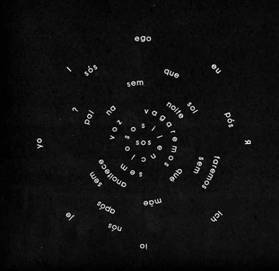 |
| |
Two examples will illustrate this transition between static paper page and kinetic computer display. SOS,
by Augusto de Campos, was originally written in 1983 (published in book
form in Despoesia, 1994, p. 27 - Figure 2, above). The title-word sos
(which, in Portuguese, means S.O.S. and is also the plural form of
“alone”) stands at the center of seven circles of letters and words. At
once a cosmological and psychological constellation, the ideogram can
be read clockwise and counterclockwise, from the outer to the inner
circle and vice-versa, and in various combinations of those four
movements. The outermost circle is made of eight words, in eight
different languages, for the personal pronoun “I”. The text seems to
re-enact the process of awareness from individual consciousness to
human consciousness, by reference to cosmological mystery of origin,
and also to human mortality. This diagrammatic reflection upon human
solitude in the universe mimics planet orbits (by allusion to past and
present scientific and literary representations) and also the pattern
of electromagnetic waves spreading outwards from a source. The
opposition “night”/ “sun” and “voice”/ “silence” are visually
translated to the black and white surface of the page.
The second poem is a computer animation of SOS developed by Augusto de Campos using Macromedia Flash [See above: Augusto de Campos, SOS (2003)]. It was first published in the CD-ROM clip-poemas (1997-2003), which comes with his latest book Não Poemas (2003).
The digital version adds color, movement, and sound to the original
text, using it as script or notation for its digital re-mediation. Some
of the possible reading paths have now been animated: the sequence of
frames offers the viewer a privileged reading sequence. The
simultaneity of the spatially organized page has been broken down by
cinematic temporality, which is now a simulacrum of the reading
movement, directing the viewer’s attention to certain syntactical
operations.
As the text
unfolds, reading itself as it were, the reader becomes aware of the
powerful association mechanisms that its ideogrammatic structure
contained, including the way in which the act of reading the poem was
designed so that it could be experienced as a replica of the
cosmological questioning of the universe. While the animation silently
reads the text, voices materialize the ultimate human horizon of
self-consciousness, interrogation, silence, death, and oblivion. Echoes
and superposition of voices further stress this individual-collective
cosmological ontology of hope and despair.
The
digital medium, especially after the combined development of hypertext
and large-scale computer networks, has led to the creation of literary
genres that are specifically digital, i.e., genres that adopt the
properties of the software and of the means of computational display as
structural elements of poetic and narrative forms. Moreover, the
digital medium has enabled authors to formalize the intra-textual and
inter-textual connections, and it has also permitted the development of
certain textual virtualities that are inherent to various typographical
genres. That is what happens when typographic visual poetry is
converted into kinetic poetry, or when combinatorial paper fiction
becomes hyperfiction. In these cases, electronic transposition and
publication is not a mere substitute for paper, because it interferes
with specific textual aspects, and thus reconfigures the formal and
semantic properties of objects according to the axis of electronic
semiosis.
The Movement Of Reading
The
Portuguese poet E.M. de Melo e Castro is also the author of an early
series of computer-animated poems, Signagens (1985-1989) [1]. Those
sequences adapt 18 of his concrete and visual texts. Again, by
re-reading the paper versions of the poems, animation may be said to
re-write those texts with reference to the specific reproduction
technology that they are now using. In some cases, what the viewer sees
is the actual accomplishment of what were suggestions of movement in
the original paper version. However, a careful analysis of the
suggestions of movement will discover that these have to be decomposed
in two different types of reverberations: while one type is a function
of imagining an iconic mimetic between ideogram and external reference,
the other type is a function of the physical and semiotic act of
reading the ideogram. We should bear in mind that many visual poems
contain this double rationale of movement, i.e., a movement that is
symbolically and mimetically associated to the object, and a movement
that is the effect of the act of reading. What this means is that
poem-object and reader-subject are split and re-joined in the field of
perspective created by the consciousness of reading as a movement in
the outer space of the page and in the inner space of the mind.
Animated
versions make clear this multi-layered polysemy of movement that takes
place in the mind of the reader of a visual poem. What often baffles
readers of concrete texts is the paradox of finding themselves before
minimal signs that are at the same time highly charged of references
and meanings. For those readers, what appears as an impenetrable
surface-only sign and an unimaginable single-word palimpsest work to
reinforce the prejudice against concrete poetics. The fact that
many poems attempt to break the discursive chains associated with the
elements contained in the poems, very often discarding syntactic
connectors, turns texts into a challenging notation that readers have
to learn to read. The word, written or spoken, is never entirely taken
for granted and even self-similarity, when it exists, is not
necessarily a trivial poetical device, at least in the most interesting
and complex texts.
In fact,
animated versions, when they are but sets of instructions for reading
ideogrammatic or pictogrammatic poems, can become didactic and,
sometimes, they provide a poorer viewing/reading experience than the
paper original. It should be noted however that many of the digital
versions of concrete texts have added extra layers of meaning by
integrating specific properties of digital production and reproduction
technologies, such as the use of color and color effects,
three-dimensionality, framing and point of view, human voice, sound
effects, music, etc. The syntax of movement and sound, as well as the
editing of image frames, enable texts to acquire the material and
formal properties associated with cinema, for instance. Melo e
Castro’s computer text animations are outstanding in this respect: so
much so that you can claim that those texts seem to have been waiting
for electronic media [2].
|
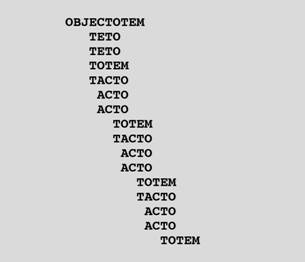 |
| |
One
example is the version of his 1962 poem objectotem (Figure 3, ab).
While the frames of the computer version re-create the reading
sequence, highlighting the internal echoes between new words and the
words contained in agglutinated word-object that makes the title, they
also add a vocal interpretation (chorus and drums) that reinforce the
representation of the poem-object as a collective totemic icon
celebrated through ritual acts. Objectivist aesthetic theory is related
to the archaic magical use of language whereby the computer version
becomes a sort of ethnographical record of concrete forms. Vocalization
and iconicity are used to suggest primeval body rhythms and primeval
forms of writing [3].
Tiago Gomez Rodrigues’ film Concretus
(2002) is a six-minute narrative that contains digital animations of
five ideograms: “tontura” by E.M. de Melo e Castro; “arranhisso”, by
Salette Tavares (1922-1994); “cascata”, “cubo” and “esfera”, by Tiago
Gomez Rodrigues (Figures 4 and 5, below). Tiago Rodrigues is also the
author of the completely digital soundtrack. This film is an inspiring
example of the marriage between concrete aesthetics and digital
technology. In Concretus, the reflection upon the specific
properties of the medium takes place in the ingenious fore-grounding of
three-dimensional digital animation techniques (shot angles, surface
textures, light sources, shadows, etc.). Concretus is not simply
illustrating the objectivist principles of concrete poems in a 3-D
environment. Elaborate suggestion of camera movement around and inside
the word-objects turns optical consciousness of the cinematic illusion
into a central element of this narrative about the nature and
possibility of concreteness in representation.
|
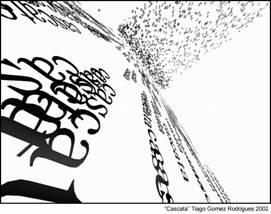 |
| |
The
tension between iconicity/mimesis/self-similarity, on the one hand, and
the abstraction provided by written signs and synthetic sounds, on the
other, is the driving force of this work. This tension shows how a
specific digital intermedia form has adopted concrete poetics to
explore its own material possibilities for meaning. The distance
between signifier and signified cannot be overcome, even when the
signifier is the signified, because that is the interval that makes
meaning possible. Considered as a narrative, this digital film-poem
points to the paradoxical nature of its objects as concrete
abstractions that exceed the pictographic logic that seems to contain
them. The movement suggested by the sequence of frames, shots, and
angles is a radical re-writing of the original ideograms, asking for a
whole new level of engagement with the concreteness of text.
|
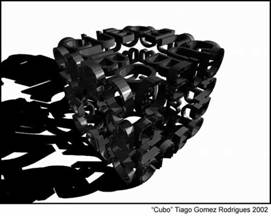 |
| |
As
for those genres that are intrinsically digital, mention should be made
of the integration of the reproduction technologies for sound, and for
reproduction and animation of images (digital or photographic) with the
technologies for the reproduction of text. The appearance of iconic and
cinematic genres, capable of bringing together elements of cinema,
video, and music with narrative and poetical forms of textual nature,
will probably be one of the future developments, as I can see in Tiago
Gomez Rodrigues work. I can imagine, for instance, a new genre in which
text and image will come together in a way that is different from what
happens in comics books and in graphic novels, displaying an ensemble
of properties that we now associate either with video, cinema, music,
computer games, virtual reality, poetry, or the novel.
Theorists
and practitioners of digital literary art, such as Michael Joyce, Loss
Pequeño Glazier, Matthew Kirschenbaum, and Johanna Drucker, have argued
that the technological features of the digital medium imply a new
consciousness of textuality. For the on-going examination of the
specificity of the digital medium, many of the most innovative
experiments of 20th-century literature appear to be extremely relevant,
because of their awareness of the fundamentals of language and textual
display. According to Glazier, the electronic on-line space, for
instance, cannot be seen simply as an environment or support for
writing, since it is already an instance of writing by itself. From
this follows the realization that poetical textures are already
embedded in the poeisis that defines the Web. In what he refers to as
the digital field, Glazier identifies three forms of electronic
textuality: a) hypertext; b) visual or kinetic text; c) works in
programmable media (see GLAZIER,
http://epc.buffalo.edu/authors/glazier/dp/intro1.html)
In my view, three properties justify the connection between the
concrete poem and the digital poem that I have tried to outline: 1st)
the spatialization that occurs in the concrete text is similar to the
topographic and iconic writing of digital interfaces; 2nd) the creation
of non-sequential reading paths (with multiple trajectories resulting
from the breaking-up of language units) is similar to the
non-sequential writing of hypertext; 3rd) the explosion of the text
into a network of allusions anticipates the notion of “literature
as a system under construction of interlinking documents” (Ted Nelson).
By means of multiple cultural associations and literary allusions,
densely packed in minimal elements, the concrete poem appears as
cluster of constellated references and meanings. Because of those three
properties, the opening of text to the probabilities of language by
means of combinatorial procedures, which was the defining principle of
concrete poetics, can now continue in the digital medium.
I finish with another poem by Augusto de Campos, both in static and kinetic versions: sem saída
[no exit] (Figure 6, right). The author is playfully subverting
the charge, aimed at the concretists, that they had led poetry to a
dead-end street. As is characteristic with Augusto de Campos, the
attempt to find a way out is literally materialized in the semiotic
processing of signs that is required from the reader. He/she has to
make sense of the lines in different colors that cross and superimpose
on the page
With its echo of Theseus in the labyrinth, in sem saída,
as in many other poems by Augusto de Campos, the act of reading with
the eye and with the mind is always the quintessential hermeneutic
experience. Once the reader has deciphered all the lines, he/she will
realize that it is not yet the way out: that was only Augusto de
Campos’ way out, his own individual thread for traveling the labyrinth
of life, language, and self. Crossword puzzle on the printed page, or
computer mouse-clicking on the electron screen or liquid crystal
display, it’s up to the reader to find his/her way. Moreover, sem saída is also a self-reflective ars poetica about
the electronic reading space, in which eyes and hand attempt to find
their way in the multiple trajectories signaled by the graphical
interface of hypertext pages. In its joyful and ironic celebration of
the achievements and shortcomings of concrete poetics, the rainbow
colors of sem saída seem to point to yet another tentative
and provisional way out, this time offered by the digital medium as a
way for extending and exploring the poetic insight about the strange
mediations that bring the world to the self in the labyrinth of
language [See above: Augusto de Campos, sem saída (2003)].
Notes
1. Signagens includes the following videopoems: As Fontes do Texto,
Sete Setas, Sede Fuga, Rede Teia Labirinto, Vibrações, Um Furo no
Universo; Come Fome; Hipnotismo; Ponto Sinal, Polígono Pessoal, O
Soneto, Oh Poética dos Meios, Concretas Abstracções, Objectotem,
Escrita da Memória, Infografitos, Ideovídeo, Diazulando, Metade de Nada
and Vibrações Digitais de um Protocubo, Do Outro Lado. Other video and
computer poems by Melo e Castro: Roda Lume (1968, 2 min. 43 s., remade
in 1986), Vogais as Cores Radiantes (1986, 3 min. 10 s.) and Sonhos de
Geometria (1993, 30 min., original soundtrack by TELECTU).
2.
In fact, Melo e Castro produced his first film-poem in 1968, Roda-Lume
[Wheel-Fire]. A computer animation of this text was later included in
the series Signagens (1985-1989).
3.
For copyright reasons, Signagens has never been published in CD-ROM
format, and so it is not possible to include an example here.
Cited Works and Further Reading
Campos, Augusto De. Não Poemas, São Paulo (Editora Perspectiva, 2003),
includes CD-ROM with the series Clip-poemas (1997-2003).
Campos, Augusto De. Despoesia, São Paulo, (Editora Perspectiva, 1994).
Campos, Augusto De. http://www2.uol.com.br/augustodecampos/home.htm (last accessed 14 Aug 2004)
Drucker,
Johanna. “Intimations of Immateriality: Graphical Form, Textual Sense
and the Electronic Environment”, in Elizabeth Bergmann Loizeaux &
Neil Fraistat, eds., Reimagining Textuality: Essays on the Verbal,
Visual and Cultural Construction of Texts (Madison: University of
Wisconsin Press, 2002, pp. 152-177).
Goldsmith, Kenneth. From (Command) Line to (Iconic) Constellation, in http://www.ubu.com/papers/goldsmith_command.html (2002) (last accessed 14 Aug 2004)
Glazier,
Loss Pequeño. Digital Poetics: The Making of E-Poetries (Tuscaloosa:
University of Alabama Press, 2002). First chapter, “Language as
Transmission: Poetry’s Electronic Presence”, also available at http://epc.buffalo.edu/authors/glazier/dp/intro1.html (last accessed 14 Aug 2004)
Greene,
Roland. “From Dante to the Post-Concrete: An Interview With Augusto de
Campos”, The Harvard Library Bulletin, Summer 1992, Vol. 3, No. 2, in
http://www.ubu.com/papers/decampos.html (last accessed 14 Aug 2004)
Joyce,
Michael. Of Two Minds: Hypertext Pedagogy and Poetics (Ann Arbor: The
University of Michigan Press, 2002 [1st ed. 1995]).
Kirschenbaum,
Matthew G. “Editing the Interface: Textual Studies and First Generation
Electronic Objects”, in TEXT: An Interdisciplinary Annual of Textual
Studies, 2002, Vol 14 pp 15-52.
Melo E Castro, E.M. Signagens (Lisboa: Universidade Aberta, 1985-89) [VHS video, 1h 30min.].
Melo E Castro, E.M. Trans(a)parências (Sintra: Tertúlia, 1989).
Melo
E Castro, E.M. Infopoesia: produções brasileiras (1996-99), in
http://hosts.nmd.com.br/users/meloecastro/ (last accessed 14 Aug 2004).
Morgan, Edwin. The Second Life (Edinburgh: Edinburgh University Press, 1980) [1st. ed. 1967].
Morgan, Edwin. http://www.edwinmorgan.com/ (last accessed 14 Aug 2004).
Nelson, Theodor Holm. Literary Machines, Mindful Press/ Eastgate Systems.
“Questionnaire of the Yale Symposium on Experimental, Visual and
Concrete Poetry since the 1960’s” (April 5-7, 1995), Questions
formulated by Eric Vos & Johanna Drucker. Replies by Augusto de
Campos, translated by K. David Jackson, in http://www2.uol.com.br/augustodecampos/yaleeng.htm (1982) (last accessed 14 Aug 2004).
Portela,
Manuel. “Hipertexto como Metalivro”, in Ciberliteratura, Coimbra:
Ariadne Editora, (2004), pp. 69-83 [forthcoming]. Also available at
http://www.ciberscopio.net/artigos/tema2/clit_05.html (last accessed 14
Aug 2004).
Rodrigues, Tiago Gomez. Concretus: um concretismo animado (Marquês Produções, CD-ROM, 2002).
Author Biography
Manuel Portela has written books of visual and sound poetry, as well as
a number of satirical poems. His early poems have been collected in
Cras! Bang! Boom! Clang (1991) and Pixel Pixel (1992). He organized an
international exhibition of visual and concrete poetry in 1993 -
Wor(l)d Poem/ Poema Mu(n)do, which was held at the Museum of Figueira
da Foz, Portugal. He has also exhibited his own visual poetry and he
has created several digital poems. Since 1994 he has published 10
volumes of translation, including the first Portuguese editions of
William Blake’s Songs of Innocence and of Experience (1994) and
Laurence Sterne’s The Life and Opinions of Tristram Shandy (2 vols,
1997-98). He was awarded the National Prize of Literary Translation for
Tristram Shandy. Many other translations have appeared in Portuguese
and Brazilian journals and anthologies, including poems by Samuel
Beckett, Edwin Morgan, Tony Harrison, John Havelda, Charles Bernstein,
Mike Basinski, Bill Howe, Ron Silliman, Bob Perelman, Dennis Cooley,
Robert Kroetsch, Roy Miki, Don Paterson. He has written short plays
both for radio and stage. His latest book is O Comércio da Literatura
[The Commerce of Literature] (2003), a study of representations of the
literary marketplace in eighteenth-century England. Currently he works
as an Assistant Professor at the University of Coimbra, Portugal. His
latest research is concerned with textual forms in digital media.

Citation reference for this Leonardo Electronic Almanac Essay
MLA Style
Portela, Manuel. " Concrete and Digital Poetics" "New Media Poetry and
Poetics" Special Issue, Leonardo Electronic Almanac Vol 14, No. 5 - 6
(2006). 25 Sep. 2006
<http://leoalmanac.org/journal/vol_14/lea_v14_n05-06/mengberg.asp>.
APA Style
Portela, M. (Sep. 2006) "Concrete and Digital Poetics," "New Media
Poetry and Poetics" Special Issue, Leonardo Electronic Almanac Vol 14,
No. 5 - 6 (2006). Retrieved 25 Sep. 2006 from
<http://leoalmanac.org/journal/vol_14/lea_v14_n05-06/mengberg.asp>
|

